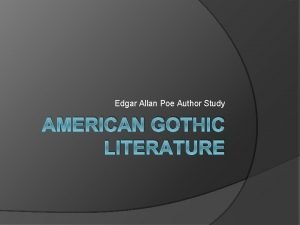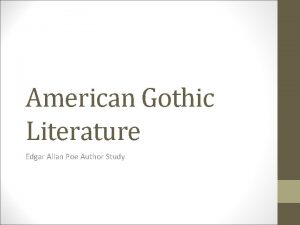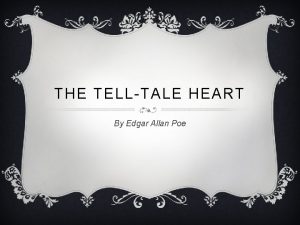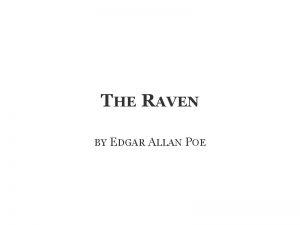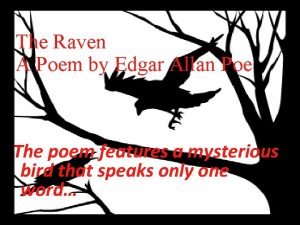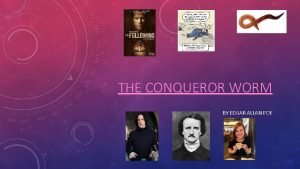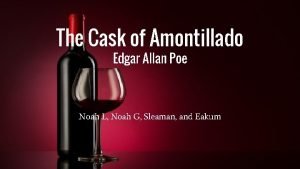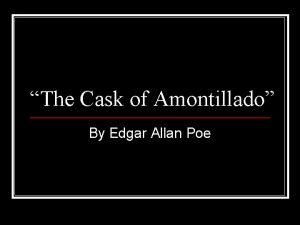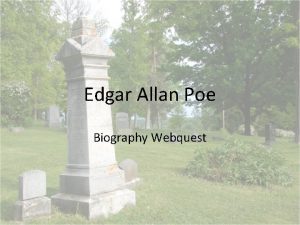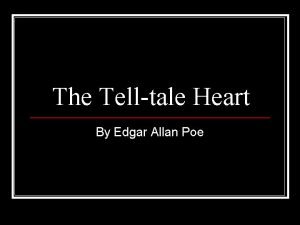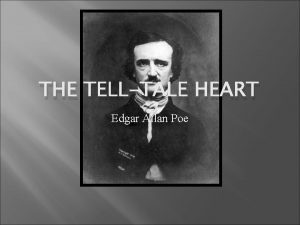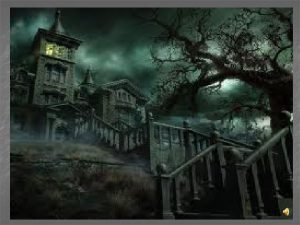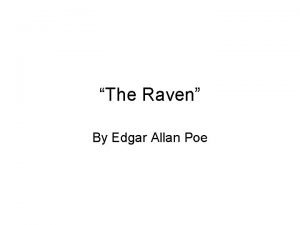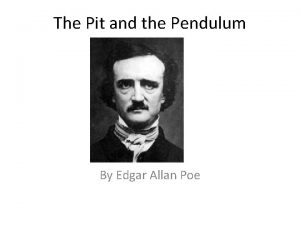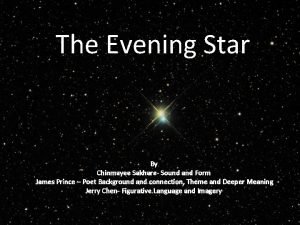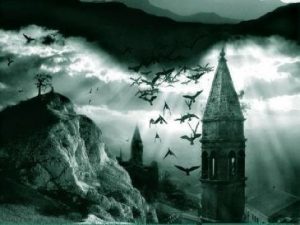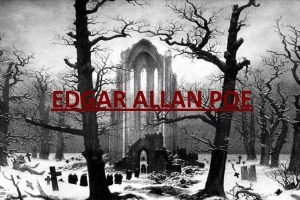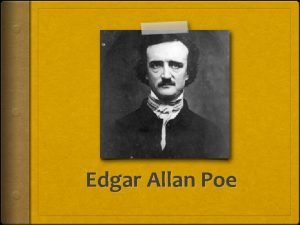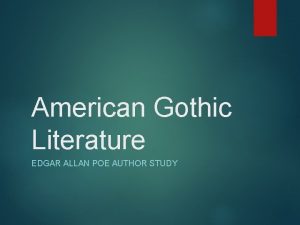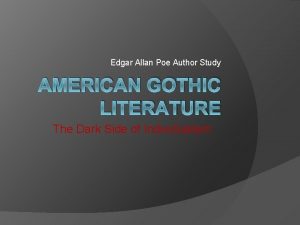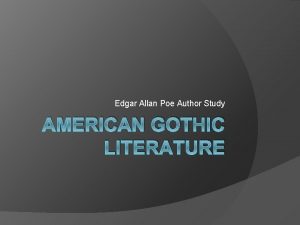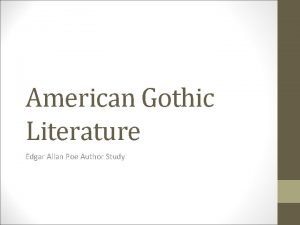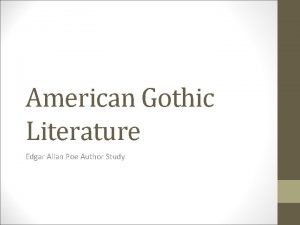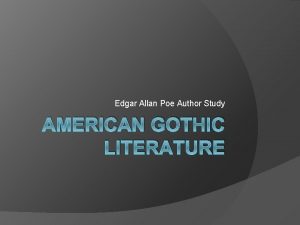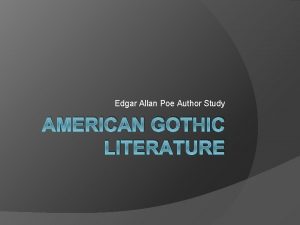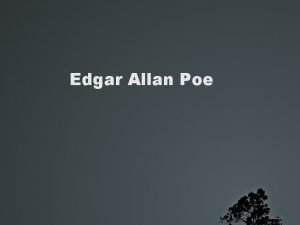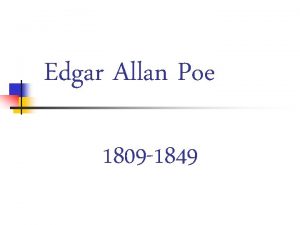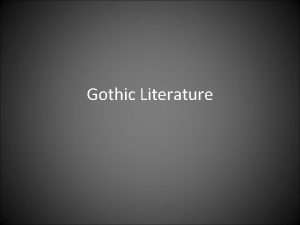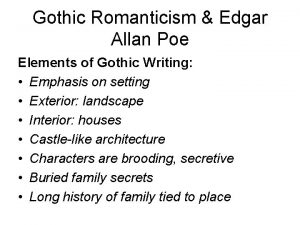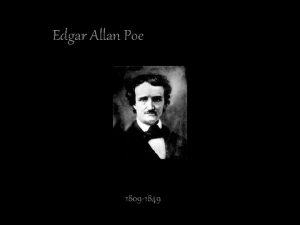American Gothic Literature EDGAR ALLAN POE AUTHOR STUDY





















- Slides: 21

American Gothic Literature EDGAR ALLAN POE AUTHOR STUDY

The Dark Side of Individualism AMERICAN GOTHIC

Gothic Literature Gothic Literary tradition came to be in part from the Gothic architecture of the Middle Ages. Gothic cathedrals with irregularly placed towers, and high stained-glass windows were intended to inspire awe and fear in religious worshipers. The Beginnings…

• Gargoyles—carvings of small deformed creatures squatting at the corners and crevices of Gothic cathedrals—were supposed to ward off evil spirits, but they often look more like demonic spirits themselves. • Think of the gargoyle as a mascot of Gothic, and you will get an idea of the kind of imaginative distortion of reality that Gothic represents.

Shifting American View After winning independence, America held a bright promise Democracy spread (in small steps) Economic promise was all around Technology was advancing at a steady pace Writers, poets, and artists work to capture and depict the best of what a nation might become.

Shifting American View The ugly truth rears its head 15% of population still considered property Women confined to home and under the authority of men Native Americans losing land power And raises questions Where was America headed? With such rapid growth, how to maintain unity and vision What is the human cost of rapid expansion and technological growth?

Exploring the Dark Side The Dark Romantics took on the questions, providing no clear answer, but illustrating the destruction taking place underneath the optimism of the Romantic period. They pose disturbing questions about Americans’ ideas of humanity, society, and the cosmos. The Dark Romantics hold up a mirror, exposing the cruelty, inhumanity, anxiety and fear that rapid expansion and technological advancement, and premature independence can evoke.

Gothicism vs. Romanticism Nature, Individualism, Imagination, Emotion Romantic writers celebrated the beauties of nature, individualism Romanticism developed as a reaction against the rationalism of the Age of Reason. The romantics freed the imagination from the hold of reason, so they could follow their imagination wherever it might lead. When Romantics looked at the individual, they saw hope (think “I Become a Transparent Eyeball”). Dark Romanticism was a reaction to the Transcendental movement, particularly its extreme optimism. Dark Romantics focus on human fallibility, selfdestruction, judgment, punishment, as well as the psychological effects of guilt and sin. Whereas Transcendentalists felt perfection and their own divinity as innate qualities of mankind Dark Romantics believed humans gravitate to evil and self -destruction

The Gothic or Dark, Dark Romanticism There's an even darker side of the Dark Romantics: Gothi c Literature, which involves sheer terror, personal torment, graphic morbidity, and the super-natural For some, the imagination led to the threshold of the unknown—the shadowy region where the fantastic, the demonic and the insane reside. When the Gothic's saw the individual, they saw the potential of evil.

Gothic Movement in America The Gothic Tradition was firmly established in Europe before American writers had made names for themselves. By the 19 th century, Edgar Allan Poe, Nathanial Hawthorne, and to a lesser extent Washington Irving and Herman Melville were using the Gothic elements in their writing. Edgar Allan Poe was the master of the Gothic form in the United States.

Watch for these 10 Elements Fascination With the Past The Supernatural Emphasis on Sexuality Horror Psychological Portraits Exotic Locales Experimental Techniques Gothic Hero (anti-hero or flawed protagonist) Repeated Use of Motifs Symbolism

Characteristics of Gothic Literature Settings most often include large, drafty old houses that have "been in the family for years. " Since castles in the American landscape were practically unheard of, early Gothic fiction writers began substituting the family estate for the traditional castle. 2. An atmosphere of mystery and suspense that is enhanced by a plot which seeks to discover the secrets lying within the supernaturally charged environment. 3. A ghostly legend, an unexplainable occurrence, or a story about a horrible death or murder that took place at the family estate in question. 4. Omens, foreshadowing, and dreams usually play a large role in the mysterious air that is created within the story. 5. Tales include highly charged emotional states like: terror, a feeling that one is on the brink of insanity, anger, agitation, an exaggerated feeling of some impending doom, and obsessive love. 6. Supernatural events: ghosts, doors that open themselves, unexplained sounds, etc. 7. Damsels in distress are frequent. Women who are frightened and confused, wandering around lost, or dying due to a slow and unexplainable ailment. 8. Words designed to evoke images of gloom and doom: dark, foreboding, forbidding, ghostly, etc. 9. Romantic themes often involve the death of a man or woman in the throes of some great passion, the obsessive nature of a man or woman in love, or excessive grief one feels upon the loss of a loved one.

Edgar Allan Poe His stories have: Themes focused on For Poe, it was only in these extreme situations that people revealed their true nature. Death Grief Obsession The supernatural Settings that feature ○ Dark, medieval castles ○ Decaying ancient estates Characters that are ○ Male—insane ○ Female—beautiful and dead (or dying) Plots that include ○ Murder ○ Live burials ○ Physical and mental torture ○ Retribution from beyond the grave

The Gothic dimension of Poe’s fictional world offered him a way to explore the human mind in these extreme situations and so arrive at an essential truth

Edgar Allan Poe During a life marked by pain and loss, Edgar Allan Poe wrote haunting tales in which he explored the dark side of the human mind. A well-read man with a taste for literature, Poe was cursed with a morbidly sensitive nature and made his feelings of sadness and depression the basis of a distinctive body of literary work. The following is a look at the life and work of a mysterious American master.

Marked by Loss Poe was born in Boston, Massachusetts in 1809, one of three children born to a couple who toured the East as actors. Before he was three years old, his father had abandoned the family, and his mother had died of tuberculosis. John and Francis Allan, took Poe to their home in Richmond, Virginia and became his foster parents. With the Allan’s he briefly lived in England, and continued his education in the United States.

A Restless Spirit This period in Poe’s life was full of high’s and lows. 1826, he started at the University of Virginia, where his reckless habits led to heavy debt, forcing him to leave school. He moved to Boston, where he published his first book, Tamerlane and Other Poems in 1827. In 1828, he was flat broke and enlisted into the army. John Allan got him an appointment at West Point, but he found the school confining and made sure he was expelled.

A Man of Letters After leaving West Point, he moved to Baltimore to live with his aunt Maria Clemm and her young daughter Virginia. There he began writing short stories. In 1834, he moved to Richmond to work for the Southern Literary Messenger. His reviews in the Messenger led to increased in the magazine’s circulation. In 1836, Poe married his cousin. Soon after, a disagreement led to him leaving the Messenger and moving again, this time to New York City. After publishing another short novel, he moved again searching for work, this time to Philadelphia.

Troubled Life and Sad End In the years following Virginia’s death, Poe struggled with despair as well as his own failing health. He moved back to Baltimore in 1849, where his health declined quickly. He collapsed on a Baltimore street where he was taken to a hospital. He died a few days later.

Reaction to Poe’s Work Poe’s work generated strong responses. Critics either loved his work, or they hated it. Shortly after his death, a one-time friend published a biography on Poe. This work established the view of Poe as a gifted, but socially unaccepted writer. This tainted his reputation in America for many years. Eventually in the United States, his reputation was regained. Today, Poe is recognized as a master of poetry, a superb writer of short stories, and a profound explorer of the torments of the human soul. He wrote only one novel, around 50 poems, and 70 short stories.

Timeline: Poe’s Life & Work 1827 Poe published Tamerlane and Other Poems 1809 Poe was born on January 19 th 1831 Expelled from West Point Publishes Poems 1839 Poe published Tales of Grotesque and Arabesque including “The Fall of the House of Usher” 1836 Poe married Virginia Clemm 1841 Poe wrote “The Murders of Rue Morgue” 1845 Poe published “The Raven” 1847 Poe dies in Baltimore on October 7 th
 Edgar allan poe author study
Edgar allan poe author study Edgar allan poe author study
Edgar allan poe author study Vocabulary tell tale heart
Vocabulary tell tale heart Themes of the tell tale heart
Themes of the tell tale heart Tell tale heart poem
Tell tale heart poem Edgar allan poe the raven summary
Edgar allan poe the raven summary Personification in the raven poem
Personification in the raven poem Edgar allan poe the conqueror worm
Edgar allan poe the conqueror worm The cask of amontillado by edgar allan poe summary
The cask of amontillado by edgar allan poe summary Catacombs edgar allan poe
Catacombs edgar allan poe Litcharts the cask of amontillado
Litcharts the cask of amontillado Edgar allan poe literary timeline
Edgar allan poe literary timeline Horacio quiroga edgar allan poe
Horacio quiroga edgar allan poe Poe webquest
Poe webquest The tell tale heart point of view
The tell tale heart point of view Richard parker allan poe
Richard parker allan poe The tell-tale heart drawings
The tell-tale heart drawings A tell tale heart questions
A tell tale heart questions Assonance in the tell tale heart
Assonance in the tell tale heart Edgar allan poe spanish inquisition
Edgar allan poe spanish inquisition Evening star edgar allan poe meaning
Evening star edgar allan poe meaning The cask of amontillado discussion questions and answers
The cask of amontillado discussion questions and answers
